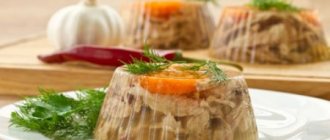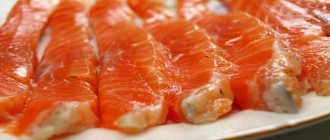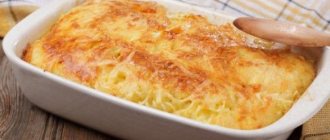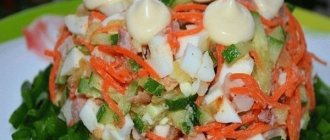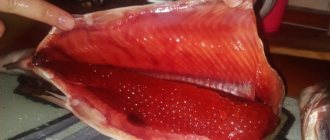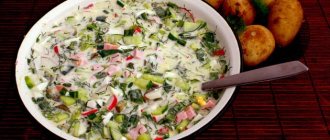Hello, friends. Today is our fish day and we will prepare aspic. Let's consider several options for preparing this dish, which will decorate any holiday table, be it New Year, March 8, or a birthday.
The process of preparing jellied fish itself is very simple, but, as in any business, you cannot do without subtleties. It often turns out that you did everything correctly, but the jelly does not harden. Sound familiar? Therefore, in this article I tried to tell you what affects this and how to make sure that there is always a guaranteed option.
Well, since I mentioned holiday tables, fish aspic coupled with salads will make your table simply magnificent, and you will earn a reputation as a jack of all trades.
Fish aspic with gelatin - a simple and tasty recipe
The first recipe will be simple, but as you prepare the recipe we will tell you about the subtleties that are the same for all the others. So make yourself comfortable and let’s get started.
Ingredients:
- Fish – 1 pc.
- Onions – 1 pc.
- Carrots – 1 pc.
- Gelatin – 1 tbsp.
- Black peppercorns – 7-8 pcs.
- Bay leaf – 1 pc.
- Lemon – 0.5 pcs.
It so happened that the pike perch had already been sold, so I had to choose which fish to take for aspic. The choice settled on grass carp. A good, large fish of the carp family with quite tasty meat. But unlike carp, there are still fewer bones in it, and they are larger, which you will agree is important. In general, this is such a beauty.
The preparation began with cutting the fish. Washed and cleaned of scales. By the way, we’ve been using this device for a long time now; the scales are easy to clean, and most importantly, they don’t scatter all over the kitchen, but stay in the sink.
After this, the head was separated and gutted. This is all left behind the scenes; the sight is not very attractive. The gills were removed from the head, and the scales were carefully collected; we will cook the broth together. The fillet was cut.
Then the fillet was immediately cut into portioned pieces. We didn’t remove the small bones; we left this for later; it’s easier to do this with cooked meat.
The scales were placed in a gauze bag and, together with the head, ridge and fins, were placed in a saucepan. Added water and set to cook. After boiling, reduce the heat so that the boil is barely noticeable. After about 15-20 minutes, spices and onions were added to the broth.
You don’t have to peel the onions; the husks will give a light, beautiful tint to the broth.
While cooking the broth, pour gelatin into a bowl and pour in a glass of cold water. Stir and leave to swell.
After about 30-35 minutes of cooking the broth, we dipped the fish pieces into it.
Bring to a boil and cook for 7-8 minutes. During this time they managed to cook. Then carefully removed it onto a plate to cool. The bulb with a bag of scales was sent into a bucket. And they took out the head and other trimmings and put them aside separately, this won’t go for aspic, but it looks like the cat will have a holiday?
The broth was poured through a sieve into another pan. It seemed a bit cloudy to us and they decided to lighten it up.
The operation, of course, is completely optional, but I would like to show you how to do it and what it leads to. To do this, beat the whites of two chicken eggs in a separate bowl and pour into the cooled broth. Immediately upon boiling there was a lot of foam, and then it practically disappeared. Boil for a couple of minutes and turn off the heat. After some time, part of the protein settled to the bottom, while the other remained floating.
Then the broth was carefully poured through... a medical cap. I’m sharing a life hack. We have been using such caps for this purpose for a long time; they cost a penny, but they filter much better than several layers of gauze. And thanks to the elastic band, they are convenient to put on pans, they hold well, and this is important when you are doing something alone. The clarified broth looks like this.
The swollen gelatin was poured into the broth, while still hot, and stirred well. Then there was a not entirely interesting task - all the bones were removed from the pieces of boiled fillet. This took approximately 7 minutes. After this, the pieces were placed in dishes, garnished with carrots and lemon, and carefully poured over the broth. We left it on the counter to cool slightly and then put it in the refrigerator.
Everything took about 1.5 hours, which, you see, is not that much. Bon appetit!
Which fish to choose for aspic?
Basic rules to follow when choosing fish:
— As a rule, more than one type of fish is not used for this dish.
— Choose fish with minimal bone content: carp, pike perch, sturgeon, salmon, pike, trout.
— The most suitable is fresh fish. Chilled is also suitable, but in no case frozen, as it falls apart when cooked.
— It is better to use whole fish; do not take fillets, as its quality is more difficult to check. Some manufacturers use stale (stale) fish to sell fillets.
— Don’t forget about the general rules for choosing fish. This process must be approached with all responsibility, since this is a perishable product.
How to make fish aspic with gelatin at home
Fish aspic can be made from any fish if you use gelatin. At the same time, it doesn’t matter to us whether it’s fatty or not, frozen or fresh, it will always work out. And if you use fish gelatin, it will turn out not only tasty, but also very healthy.
Ingredients:
- Fish – 0.8-1 kg. (any)
- Carrots – 1 pc.
- Onions – 1 pc.
- Bay leaf – 2-3 pcs.
- Black peppercorns – 3-5 pcs.
- Salt - to taste
- Gelatin – 2 tbsp.
For the recipe, we take about a kilogram of absolutely any fish, the main thing is that it has a beautiful appearance, after all, we will have aspic, not jellied meat.
Pour a couple of tablespoons of gelatin into a bowl and pour a glass of cold water, stir everything well and leave to swell.
Place a pan on the stove and pour about 650 ml of water into it. Add carrots, unpeeled onions, black peppercorns and bay leaves to the pan. Turn on maximum heat and bring to a boil.
We will need carrots to decorate the dish, and onions to enhance the taste of the broth, its light golden color and lightening. Do not remove the skin from the onion, just wash it under the tap.
When the water boils, drop the fish into it.
Bring to a boil and reduce the heat to the very minimum, the water should boil almost imperceptibly, not even boil, but slightly bubble. Salt the broth, remove the foam from above, close the pan itself with a lid, leave a small crack and cook until the fish is ready.
It is impossible to say the exact cooking time for fish; it is all cooked differently depending on the type and size of the pieces. If you have, for example, a large piece of carp, it can be cooked for 30 minutes, and portioned pieces will be cooked in 15. In general, the average cooking time for fish is 10-15 minutes. Our pieces took just that long to cook.
When the fish is cooked, remove it from the broth. At the same time, we taste the broth itself; if there is not enough salt, add more salt.
We throw the onion out of the broth, it has served its purpose, and remove the carrots and let it cool. After cooling, cut into circles that will be used to decorate the aspic.
Pass the broth through 2-3 layers of gauze into another pan.
If you really want, the broth can be further clarified. To do this, beat a couple of egg whites with a whisk and pour them into the cooled broth. I repeat, the broth should be warm, not hot! Then turn on the heat and bring to a boil, cook for a couple of minutes. Turn off the heat and remove the protein floating on top. Let the sediment settle to the bottom, then carefully strain through cheesecloth into another pan.
Pour the swollen gelatin into the hot broth and mix well. And for now we put it aside.
Carefully separate the fish from the bones and cut into portions. The size of the pieces depends on your imagination and the future dish.
And then we begin the creative process. As they say, it’s not enough to just serve fish, it must be presented beautifully. Pour some broth into a beautiful dish and put it in the refrigerator to cool for 15-20 minutes.
After the bottom layer of broth has hardened, place pieces of fish on it.
Place lemon slices between the fish and carrot slices in the center. Add green peas and sprigs of herbs.
Then carefully pour in the rest of the broth and put it in the refrigerator to harden. After complete hardening, serve.
It is best to prepare the aspic in advance, for example a day before the holiday; it still needs time to harden.
Bon appetit!
Tips for clarifying fish stock for aspic
All ingredients of the aspic should be clearly visible in the finished dish. This cannot be achieved if the broth is cloudy. To make the jelly completely transparent, use the following tips.
- As soon as the broth for the fish aspic has boiled, you need to remove the foam with a slotted spoon, and then cook over low heat. This will make your broth clear.
- If the broth turns out to be cloudy, you need to use clean gauze folded in four to strain it several times.
- A great way to lighten any broth is to whisk an egg white. If you pour it in a stream into a hot meat broth, it will immediately become lighter. When the broth cools, the coagulated protein will settle and can be easily removed.
Transparent red fish aspic
Aspic made from red fish looks very impressive. Thanks to its decor, it will decorate any holiday table, and thanks to its taste, it will not leave anyone indifferent.
Ingredients:
- Red fish pieces - 500g.
- Carrots – 1 pc.
- Onions – 1 pc.
- Bay leaf – 3 pcs.
- Black peppercorns – 10 pcs.
- Gelatin – 2 tbsp.
- Green peas - for decoration
- Quail eggs - for decoration
- Lemon and herbs - for decoration
For the aspic, we will use store-bought steaks and a salmon soup set.
By the way, to give a good taste to the broth, the salmon soup set can be used with any fish. It’s inexpensive, but it’s perfect for improving broth. It consists of a head, bones and fins, everything that suits best in our case. Just remember to remove the gills, they impart an unpleasant bitterness.
Instead of salmon steaks, you can take pink salmon and the same soup set. In the meantime, put the fish, carrots, onions, bay leaf and pepper into the pan. Fill with cold water.
Pour in enough water to just cover the fish, you don’t need much.
At the same time, in another container, pour a glass of cold water into the gelatin to swell.
Turn on the heat under the pan, bring to a boil, add salt and cook over low heat until the fish is cooked. Remove the foam from above.
In our case, the salmon was cooked for about half an hour. Carefully remove everything from the pan and strain the broth through a fine sieve. We remove excess fat from the strained broth using a paper napkin; to do this, lower the napkin into the broth and immediately take it out. Repeat this again with another napkin.
By this time, the gelatin has already swollen, pour it into the hot broth and mix well. Pour a little broth into the bottom of a beautiful dish and lay out the fish. Place slices of carrots, green peas and pre-boiled quail eggs on the fish.
It’s better not to give any recommendations here. It all depends on your imagination. You just need to make the dish beautiful. But even if you don’t succeed in it, it doesn’t matter, your loved ones, I’m sure, will still appreciate it.
Pour in hot broth and leave to cool at room temperature. After cooling, put it in the refrigerator until completely hardened. If you turn the aspic into another dish, it will turn out even more beautiful.
Bon appetit!
Jellied canned fish - quick and easy
If unplanned guests are expected to arrive soon, in just a couple of hours you can treat them to a delicious and easy-to-prepare canned aspic. Any fish is suitable for its preparation, be it in its own juice or in oil. All ingredients in the recipe are indicated for 8 servings; if necessary, you can increase or decrease according to the number of guests.
Ingredients:
- sardine in oil – 2 b.;
- chicken bouillon cube – 4 pcs.;
- gelatin – 30 g;
- water – 2 l.;
- spices and salt.
Preparation:
Dissolve the gelatin according to the instructions on the package immediately in a saucepan. Leave it for about 15 minutes. Add ¼ of the remaining liquid and put on the fire until it is completely dissolved in the heat, without bringing to a boil. At the same time, prepare the plates in which you will serve the dish.
Advice! To make the canned aspic look like a complete dish when served, you can put green peas and slices of boiled carrots next to the pieces of fish, and decorate the top with half a hard-boiled quail egg and a parsley leaf.
Pour the remaining water into a small saucepan. Add the juice and liquid from canned fish there and crumble the bouillon cubes. Bring the mixture to a boil, turn off the heat. Now leave the base for the aspic in a cool place so that it comes to room temperature faster. Then add the swollen gelatin into it. Finally, pour the broth over the fish and place in the refrigerator for 30 minutes until the mixture hardens.
Fish aspic without gelatin
A very good fish for aspic is carp. It is inexpensive, it tastes good, and most importantly, it contains a lot of gelling agents, which allows you to make aspic without gelatin. One minus is the bones, but they are easily removed from the cooked fillet.
Ingredients:
- Carp – 1 piece. (average)
- Onions – 1 pc.
- Carrots – 1 pc.
- Root parsley – 2 pcs.
- Black peppercorns – 10-12 pcs.
- Salt - to taste
- Lemon - for decoration
First, let's prepare the fish. We wash it, clean it from scales, cut off the head, fins and tail. We remove the gills from the head and gut the carcass.
The only thing you can immediately throw away is the gills and offal. Do not throw away the scales, they contain a lot of gelling substances.
We cut the fillets from the carcasses and cut them into portions.
We also leave the spine and ribs. Don’t think about small bones in fillets yet; it’s better to remove them from boiled fish, it’s much easier.
In a saucepan we put the onions, carrots, fins, head, tail and all the trimmings from the fish, as well as the scales, which were previously placed in a fabric bag. Add bay leaf and black peppercorns. Fill with cold water, just enough to cover everything, no more.
Place on the fire and bring to a boil. After boiling, remove the foam, add salt and reduce the heat to low. Cook at the lowest simmer for about 40 minutes.
After the time has passed, add carp fillets cut into portions into the broth and cook for another 10-15 minutes.
When adding fish pieces, the boil will stop, add gas a little and bring to a boil, and then reduce again. The broth should not boil too much.
When the fish is completely cooked, remove everything from the pan. Discard the onion, tail, head, bones and ribs, as well as scales. Strain the broth into another pan.
Carefully remove small bones from the fillet pieces. Cut the carrots into circles. And then we move on to creating a beautiful dish. After this, fill everything with strained broth.
Leave to cool at room temperature and then put in the refrigerator to harden completely.
Bon appetit!
Cod fillet
Cod, cooked in any form, has an extremely mild flavor. It is often prepared for children. Of course, jellied fish cannot please little gourmets, but older ones will certainly enjoy the dish.
Components:
- 1 kg cod;
- 1 onion;
- 1 egg;
- 1 carrot root;
- 1 lemon;
- 1/3 cup cream;
- allspice, laurel leaves, salt.
Cooking technology:
- We cut the cleaned cod into portions; we do not throw away the tails and heads, but use them for broth. Add vegetables and spices to them and cook for about an hour. Squeeze lemon juice into the pan.
- We strain the broth, throw away everything that is not needed, and divide the meat into pieces. Divide the fish into two approximately equal parts, mix one of them with cream.
- Place the meat in the container chosen for serving, fill it with creamy broth and take it to a cold place to harden.
- Eggs need to be boiled, cut into cubes or strips. We cut carrots the same way. Place the ingredients on the frozen aspic, fill with clear broth, and place in a cold place.
Article on the topic: How to make tartlets at home
Pink salmon aspic - step-by-step recipe
I would like to present another version of red fish aspic, but much more budget-friendly than the previous one. And let’s take pink salmon for this. It will also look great in appearance.
Ingredients:
- Pink salmon – 1 pc.
- Onions – 1 pc.
- Gelatin – 1 tbsp.
- Water – 600ml. (approximately)
- Bay leaf – 1 pc.
- Black peppercorns – 10 pcs.
- Salt - to taste
- Lemon, carrots, egg, corn, peas, greens - for decoration
Before cooking, prepare the fish. To do this, we clean it, clear it of scales, but do not throw out the scales, gut it and remove the head. We remove the gills from the head, but leave the head itself.
I repeat once again: for aspic, never throw out the head, fins, tails and scales. Only the giblets and gills can be discarded from the fish. Everything else is necessary because it contains gelling agents. To prevent the scales from floating around the pan, place them in a cloth or gauze bag, and simply throw them away after cooking.
We cut the fish into portions, and place the scales, along with the fins, tail and head, in a gauze bag, which after cooking will go into a bucket.
We do not peel the onions, but simply wash them under running water; we clean the carrots of dirt. Pour gelatin into a bowl and pour half a glass of cold water, stir and leave to swell.
We have all the ingredients prepared, let's move on to cooking. Pour about 600 ml of cold water into the pan and put on fire. Salt and bring to a boil. Then we send a bag with bones and fins. After boiling again, reduce the heat and cook for about 10-15 minutes. Remove foam from the surface.
After the time has passed, add the onion, carrots, and all the spices. Continue cooking for about another 20-25 minutes. If foam appears, remove it.
Then add portioned pieces of pink salmon, increase the heat slightly and bring to a boil. After this, reduce the heat to low so that the boil is barely noticeable and cook for about 7 minutes. Remove foam from the surface.
Why exactly 7 minutes, everything is simple, during this time the pieces of pink salmon have time to cook. If you cook longer, they will begin to disintegrate into fibers.
After this, remove the pan from the stove, carefully remove the fish pieces from the broth onto a plate, and throw away the bag with the tripe. Pour the swollen gelatin into the broth and mix well.
If you did not use high heat when cooking, then, as a rule, the broth is quite clear and does not even require straining through cheesecloth. But if you don’t like transparency, then you can strain it into another pan through several layers of gauze and lighten it using the method from previous recipes.
Carefully remove the skin from the fish pieces and remove the bones. Then arrange it beautifully on a platter. Decorate with carrots, corn and herbs.
It’s difficult to give recommendations on decoration, use your imagination? Or read this article at the very end, I will try to give several options for decorating the dish.
Carefully pour in the broth and leave at room temperature to cool. After this, put it in the refrigerator or cold balcony to completely harden.
Serve immediately before the holiday. Bon appetit!
Very tasty aspic from grass carp
When using river fish for preparing various dishes, including aspic, it is worth remembering that the fillet contains many small bones, which will take a long time to select. But at the same time tender, fatty and juicy grass carp meat is worth spending time on. It is thanks to this that the aspic has an excellent taste and aroma.
Ingredients:
- grass carp – 2 kg;
- onions – 3 pcs.;
- carrots – 3 pcs.;
- beets – 2 pcs.;
- laurel leaf – 4 pcs.;
- spices and herbs.
Preparation:
If the carcass is whole, then first clean it of scales, then gut it, remove the gills and rinse well under running water. Be sure to use the head to cook the broth, after cutting it in half. Also prepare the vegetables and cut them into slices about 5 mm thick.
Place beets in layers in a saucepan, then fish, onions, and carrots. Sprinkle everything on top with salt, spices and herbs. Fill with cold water so that it covers the workpiece by about 2 cm from above and put on fire. When the mixture begins to boil, reduce the flame and simmer over medium heat without a lid for half an hour.
Then turn it off, carefully remove the fish and let it cool. Try to remove the bones from the pieces so that they remain intact. After this, place the boiled beets, carrots, and pieces of grass carp on top. Pour the remaining broth over everything and put it in the refrigerator. As soon as the mass has hardened, serve.
Which fish is best for aspic?
As you have already seen from previous recipes, aspic can be prepared from different fish. But why then does such a question arise? Yes, because sometimes it does not freeze, but remains a broth. In order for the aspic to be guaranteed to harden, three conditions are necessary: either the fish is very fatty, or it must contain a lot of gelling substances, or simply use gelatin.
In almost all previous recipes, I wrote that under no circumstances should you throw out a fish’s head, fins, spine, tail or scales, for the simple reason that they all contain the same gelling substances that are necessary for the aspic to harden. And if your fish is not cleaned, gutted and headless, and you do not pour in a lot of water for cooking, then eventually the broth is guaranteed to harden as it cools.
It’s another matter if you bought already gutted fish, or even fillets. Here, of course, you can’t do without gelatin, it’s simply necessary. But in this case there is a big plus: your broth will be the most transparent and you won’t have to forcibly clarify it.
In general, gelatin makes aspic of the best quality, so there is no need to strive to make it without it. And the worst thing will happen after cooking fatty fish. In this case, the cooled filling turns out loose, cloudy and unsightly.
I think you have already guessed what the answer will be to the question about the best fish. Just be guided by your taste and choose the most delicious one. And by adding gelatin, your broth is always guaranteed to harden.
How to cook jellied fish
It’s easy to confuse fish aspic and jellied meat, but they are prepared differently: aspic is prepared from a rich broth to which gelatin is added. It is mandatory in its preparation that the water should be absolutely transparent, and you can decorate it at your discretion.
Recipe for jellied fish with gelatin
There are many recipes for preparing jellied fish with the addition of gelatin. The main thing in its preparation is to follow a certain sequence of actions in order to achieve the desired result. For this you will need:
- whole fish (optional);
- gelatin – 10 g;
- vegetables of your choice.
- Boil broth from the head and tail of the fish. This will take approximately 1 hour.
- Prepare gelatin.
- Remove parts of the fish from the finished broth and strain through cheesecloth until transparent.
- When the liquid becomes clear, add gelatin and heat everything together without letting it boil.
- Pour the prepared base over it and place it in the freezer to harden.
Fish aspic without gelatin
Fish aspic is made without adding gelatin, but it takes longer to harden. This recipe is simpler and suitable for those who do not like a thick consistency. This dish is prepared in exactly the same way, only the moment with the addition of gelatin is skipped. Red fish is best suited for such a dish (the ridges freeze well), since it will be impossible to achieve the traditional version with white fish due to its high fat content.
How to beautifully serve fish aspic
There are so many ways to serve aspic that they are limited only by your imagination. To do this, you can use salad bowls, both simple and ceramic; you can make small aspic bowls in large glasses or round glasses. Recently it has become fashionable to make in silicone molds. It turns out very impressive.
Or look at the collage, I have collected interesting options for serving aspic. It's amazing to see, and some of them are simply breathtaking.
Carrots, lemon, green peas, olives and bell peppers will be the best products for decorating aspic. After hardening, a real picture can be obtained.
And finally, especially for those who like to watch recipes more than read, I have an interesting video that I want to show you.
That's all for me, I hope everyone will appreciate your aspic. Well, I say goodbye to you, until we meet again.
Sincerely, Alexander.

